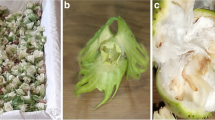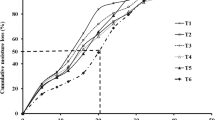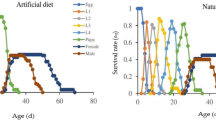Abstract
Pink bollworm, Pectinophora gossypiella (Saunders) (Lepidoptera: Gelechiidae) is the most destructive insect-pest among the bollworm complex of cotton in the recent epoch. The global downfall in cotton production is attributed to the increasing resistance developed in bollworms especially the P. gossypiella. An efficient mass production system is a pre-requisite to address such yield losses. Inadequate historical investigations lead to initiate the present study. Locally available and cost effective materials were evaluated to find their impact on the adult biology of P. gossypiella under laboratory condition maintained at 27 ± 2 °C, 60 ± 10% relative humidity, and 14:10 (L: D) photoperiod. The principle parameters of P. gossypiella biology included pre-oviposition, oviposition, post oviposition, female and male life span, fecundity, and average fecundity. Results revealed that the moths started to deposit eggs within 2.33 ± 0.33 to 3.00 ± 0.00 days. The female moths laid 238.00 ± 3.79 eggs, spent 13.67 ± 0.33 and 6.67 ± 0.67 days as oviposition and post-oviposition period when muslin cloth (black) was used as oviposition substrate. The male and female completed their life span in 49.11 ± 0.04 and 59.15 ± 0.03 days respectively. The research findings lead to the conclusion that muslin cloth (black) could be used as a substitute of Gouche sheets for oviposition among the indigenous substrates. Hence, the use of muslin cloth (black) as oviposition substrates can contribute towards an efficient and cost effective rearing system for Pectinophora gossypiella (Saunders) (Gelechiidae: Lepidoptera) with special emphasis on fecundity.












Similar content being viewed by others
References
Adkisson PL (1961) Fecundity and longevity of the adult female pink bollworm reared on natural and synthetic diets. J Econ Entomol 54:1224–1227. https://doi.org/10.1093/jee/54.6.1224
Anonymous (2021) Pakistan Bureau of statistics, Economic Survey of Pakistan Page 20
Bell RA, Joachim FG (1976) Techniques for rearing laboratory colonies of tobacco hornworms and pink bollworms. Ann Entomol Soci 69:365–373. https://doi.org/10.1093/aesa/69.2.365
Chatzigeorgiou AC, Papadopoulos NT, Prophetou-Athanasiadou DA (2010) Effect of cotton cultivars on the oviposition preference of pink bollworm (Lepidoptera: Gelechiidae). J Pest Sci 83:289–296
Fabrick JA, Jech LF, Henneberry TJ, Carriere Y (2009) Novel pink bollworm resistance to the Bt toxin Cry1Ac: Effects on mating, oviposition, larval development and survival. J Insect Sci. https://doi.org/10.1673/031.009.2401
Fabrick JA, Unnithan GC, Yelich AJ, DeGain B, Masson L, Zhang J, Tabashnik BE (2015) Multi-toxin resistance enables pink bollworm survival on pyramided Bt cotton. Sci Rep 5:1–13. https://doi.org/10.1038/srep16554
Fand BB, Nagrare VS, Deshmukh V, Naikwadi BV, Gokte-Narkhedkar N, Waghmare VN (2020) A simple and low-cost laboratory rearing technique for pink bollworm, Pectinophora gossypiella (Suanders)(Lepidoptera: Gelechiidae) using detached green bolls of cotton. Phytoparasitica 48:25–33
Gahukar RT (2006) Improving the conservation and effectiveness of arthropod parasitoids for cotton pest management. Outlook on Agriculture 35:41–49. https://doi.org/10.5367/000000006776207717
Hariprasad KV (1999) Ecobiology and behavioural aspects of the pink bollworm, Pectinophora gossypiella (Saund.)(Lepidoptera: Gelechiidae) infesting cotton. J Entomolo Res 23:149–155
Henneberry TJ, Clayton T (1980) Pink bollworm: mating, reproduction, and longevity of laboratory reared and native strains. Ann Entomol Soci 73:382–385. https://doi.org/10.1093/aesa/73.4.382
Henneberry TJ, Clayton TE (1990) Pink bollworm (Lepidoptera: Gelechiidae): laboratory studies on the effect of cotton plant material on mating and oviposition of laboratory-reared and feral moths. J Econ Entomol 83:1837–1840. https://doi.org/10.1093/jee/83.5.1837
Henneberry TJ, Leal MP (1979) Pink bollworm: effects of temperature, photoperiod and light intensity, moth age, and mating frequency on oviposition and egg viability. J Econ Entomol 72:489–492. https://doi.org/10.1093/jee/72.4.489
Henneberry TJ, Flint HM, Bariola LA (1977) Temperature effects on mating, sperm transfer, oviposition, and egg viability of pink bollworm. Environ Entomol 6:513–517. https://doi.org/10.1093/ee/6.4.513
James C (2011) Global status of commercialized biotech/GM crops. 2011 (Vol. 44). Ithaca, NY: ISAAA
Jothi BD, Naik VCB, Kranthi S, Kranthi KR, Valarmathi R (2016) Viable mass production method for cotton pink bollworm, Pectinophora gossypiella (Saunders). J Basic & Appl Zool 73:9–12. https://doi.org/10.1016/j.jobaz.2015.09.004
Jothi BD, Valarmathi R, Nagarajanm T, Rajan T (2010) Larval sex differentiation of pink bollworm–an easy tool for pairing of adults for mass rearing. CICR Newsletter Nagpur 26:5
Kranthi KR (2002) Modalities of Bt cotton cultivation in India, its pros and cons including resistance management and potential ecological impact. IN: Khadi, BM (ed): Bt Cotton Scenario with special Reference to India
Kranthi KR, Kranthi NR (2004) Modelling adaptability of cotton bollworm, Helicoverpa armigera (Hübner) to Bt-cotton in India. Curr Sci 1096–1107
Malthankar PA, Gujar GT (2014) Dietary influence on the biology and the susceptibility of pink bollworm, Pectinophora gossypiella (Saunders)(Lepidoptera: Gelechiidae) to Cry1Ac Toxin from Bacillus thuringiensis. Biopestic Int 10:152–159
Mapuranga R, Chapepa B, Mudada N (2015a) Strategies for integrated management of cotton bollworm complex in Zimbabwe: A review. Int J Agron Agri Res 7:23–35
Mapuranga R, Chapepa B, Mudada N (2015b) Strategies for integrated management of cotton bollworm complex in Zimbabwe: A review. Int J Agron Agric Res 7:23–35. SSN: 2223–7054 (Print) 2225–3610 (Online)
Muralimohan K, Kamath SP, Mohan KS, Ravi KC, Deeba F, Sivasupramaniam S, Head GP (2009) Mass rearing diet for the pink bollworm Pectinophora gossypiella (Lepidoptera: Gelechiidae) and its susceptibility to insecticidal Bt proteins. Int J Trop Insect Sci 29:102–107. https://doi.org/10.1017/S1742758409990129
Nair RV, Kamath SP (2018) An effective artificial oviposition substrate for Pectinophora gossypiella. Entomol Exp Appl 166:603–606. https://doi.org/10.1111/eea.12669
Naranjo SE, Martin JM (1993) Comparative development, reproduction, and oviposition of pink bollworm (Lepidoptera: Gelechiidae) on a resistant okra-leaf cotton and commercial upland and pima cultivars. J Econ Entomol 86:1094–1103. https://doi.org/10.1093/jee/86.4.1094
Rajput IA, Lodhi AM, Syed TS, Abro GH, Khatri I (2019) Comparative Biology of Pink Bollworm, Pectinophora gossypiella Saund. on Bt. and Non-Bt. Cotton. Biol Sci -PJSIR 62:116–121. https://doi.org/10.52763/PJSIR.BIOL.SCI.62.2.2019.116.121
Reyaz AL, Balakrishnan N, Udayasuriyan V (2018) A new observation on feeding behaviour of pink bollworm and its application in screening Bt-resistant population. 3 Biotech 8:1–6. https://doi.org/10.1007/s13205-018-1262-7
Sabry KH, Abdel-Aziz NF (2013) Resistance and enzyme assessment of the pink bollworm, Pectinophora gossypiella (Saunders) to Spinosad. J Animal Plant Sci 23:136–142
Shah V, Pande R, Verma P, Gokte-Narkhedkar N, Waghmare VN (2020) Identification of oviposition deterrents from pink bollworm, Pectinophora gossypiella (Saunders). J Environ. Biol 41:644–649. https://doi.org/10.22438/jeb/41/3/MRN-1188
Shorey HH (1964) The biology of Trichoplusia ni (Lepidoptera: Noctuidae). III. Response to the oviposition substrate. Ann Entomol Soci 57:165–170. https://doi.org/10.1093/aesa/57.2.165
Shrinivas A, Hanchinal S, Hurali S, Beldhadi R (2019) Comparative biology of pink bollworm, Pectinophora gossypiella (Saunders)(Lepidoptera: Gelechiidae) on different hosts. J Entomol Zool Stud 7:1053–1060
Tabashnik BE, Dennehy TJ, Carrière Y (2005) Delayed resistance to transgenic cotton in pink bollworm. Proc Natl Acad Sci 102:15389–15393. https://doi.org/10.1073/pnas.0507857102
Vanderzant ES, Reiser R (1956) Aseptic rearing of the pink bollworm on synthetic media. J Econ Entomol 49:7–10. https://doi.org/10.1093/jee/49.1.7
Vanderzant ES, Reiser R, Ivy EE (1956) Methods for the mass rearing of the pink bollworm. J Econ Entomol 49:559–560. https://doi.org/10.1093/jee/49.4.559
Wu HH, Huang MS, Peng WAN, Wyckhuys KA, Wu KM (2013) Emergence, mating and oviposition behavior of the Chinese population in pink bollworm, Pectinophora gossypiella (Lepidoptera: Gelechiidae). J Integr Agric 12:653–662. https://doi.org/10.1016/S2095-3119(13)60283-X
Wu H, Wu K, Wang D, Guo Y (2006) Flight potential of pink bollworm, Pectinophora gossypiella Saunders (Lepidoptera: Gelechiidae). Environ Entomol 35:887–893. https://doi.org/10.1603/0046-225X-35.4.887
Wu JP, Wu HH, Wan P, Huang MS (2008) Technique for rearing the pink bollworm (Pectinophora gossypiella) with artificial diet. Hubei Agric Sci 47:7
Zinzuvadiya HD, Desai HR, Lakum MB, Rajkumar BK (2017) Biology of pink bollworm, Pectinophora gossypiella Saunders (Lepidoptera: Gelechiidae) on artificial diet under controlled condition. Trends Biosci 10:5363–5371
Acknowledgements
The authors are thankful to Punjab Agriculture Research Board (PARB) for providing the financial aid (project code 888) for the smooth execution of the entire research work.
Funding
The authors have no relevant financial or non-financial interests to disclose.
Author information
Authors and Affiliations
Corresponding author
Additional information
Publisher's Note
Springer Nature remains neutral with regard to jurisdictional claims in published maps and institutional affiliations.
Rights and permissions
About this article
Cite this article
Akhtar, S., Arif, M.J., Gogi, M.D. et al. Impact of various oviposition substrates on biology of pink bollworm Pectinophora gossypiella (Lepidoptera: Gelechiidae) under laboratory conditions. Int J Trop Insect Sci 42, 2987–2993 (2022). https://doi.org/10.1007/s42690-022-00829-z
Received:
Accepted:
Published:
Issue Date:
DOI: https://doi.org/10.1007/s42690-022-00829-z




